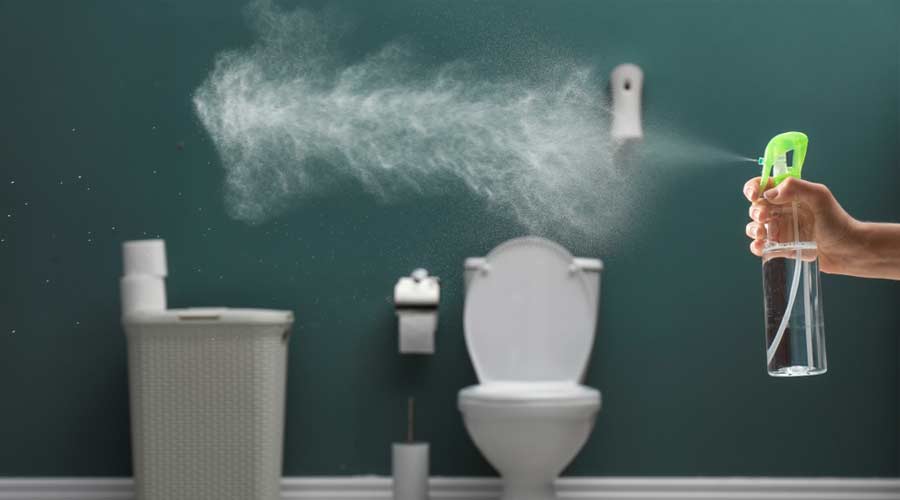
Your restroom may be a picture-perfect showplace of sparkling tile, gleaming fixtures, and a seemingly never-ending supply of consumables, but all that means nothing if it doesn’t pass the sniff test. Foul smelling restrooms frequently top lists of most common public bathroom complaints. And an unpleasant restroom experience reflects poorly on the establishment.
“Surveys have shown that 86 percent of adults equate the cleanliness of a restroom with overall cleanliness of a facility,” says Eric Cadell, vice president, Dutch Hollow Supplies, Belleville, Illinois. “Seventy-five percent of adults would not return (or limit their return) to a business that has a dirty restroom; and 50 percent of people who encounter a dirty restroom tell friends, family and social media about it.”
Not all unpleasant restroom smells are alike. Sometimes restrooms stink for obvious and expected reasons. Luckily, these disagreeable little facts of life usually dissipate quickly, even faster if the facility features good ventilation. It’s those lingering odors — a strong ammonia scent, sewer gas, or mold — that stick around even after cleaning that present the real problem.
Here are ways to remove malodors and create a welcoming space that smells as good as it looks.
Urine Trouble
The biggest culprit for creating restroom malodors is urine. Urine causes odors in two distinct ways. The first, as explained in a blog by Uttam Banerjee, happens when the substance comes in contact with fresh water. According to the blog, when the urea in urine meets the fresh water in a urinal or toilet, it hydrolyses and creates ammonia.
Although this is an issue, the main problem with urine is the bacteria that feed on it. Urine can end up on the floor, either by splashing, poor aim or a vigorous toilet plume. Bacteria eventually finds it, settles in, chows down and starts producing smelly waste. If left untreated, the urine changes over time from an acid to an alkaline salt. These salts attract more moisture and more bacteria to create stronger and stronger smells.
Getting rid of that urine/bacteria combo is the best way to remove foul odors from restrooms. To do so, staff must first discover where the smell is coming from. Porous grout lines are the most popular spot for urine and bacteria to hang out, but they are not the only hiding places.
“Older restrooms have a lot of places for soil and urine to hide, so you have to act like a detective,” says Dana Pawlak, south sales manager, ATRA Janitorial Supply Co, an Envoy Solutions Company, Pompton Plains, New Jersey. “Cracks in the tiles, drill holes for stall partitions, and wall joints are all potential hotspots.”
Common cleaning tools, like a bucket and string mop, can make the problem worse.
“Traditional damp mopping pushes dirt, organic salts, bodily fluids, and more into the grout lines instead of actually removing them from the restroom,” notes Cadell.
Cadell instead suggests investing in alternative cleaning methods like a restroom cleaning machine that “uses low pressure to apply a cleaner to all restroom surfaces, including vertical surfaces. Then it applies a clean water rinse, and the water is recovered through a vacuum process. With this approach, all the dirty water is removed completely from the restroom.”
Pawlak adds that, “newer cleaning technologies such as microfiber mops with double-bucket systems or compact scrubbers can significantly improve daily floor cleaning procedures.”
In addition to equipment, choosing the right restroom cleaning chemistry will help keep grout lines and other smelly spots fresh. Cadell recommends using a hydrogen peroxide-based product to remove soils and an enzyme-based product to keep working on uric salts and bodily fluids.
Another place to look for bad, urine-based smells is the urinal itself.
“We had an instance where the urinal contained a mechanism meant to improve flushing, but the device also harbored build up,” says Pawlak. “Sometimes technology made to correct one problem creates another.”
Drains and Dry Pipes
Aside from urine and the complications that can subsequently arise from it, floor drains are another potential hotspot when it comes to bad restroom smells.
“It is a common misconception that the floor drain is always being cleaned because the residual water and cleaning solution get rinsed down it,” explains Cadell. “In reality, drains are a breeding ground for bacteria and mold.”
Using an enzyme-based product can remove these odors, notes Ray Ranger, director of healthcare markets for Triple-S, San Juan, Puerto Rico.
“A fast-acting, instant odor counteractant helps neutralize unpleasant smells,” he adds. “These products are specifically formulated to eliminate malodor and not just mask bad smells.”
Enzyme products work by digesting both the smelly bacteria and the food source that bacteria and molds need to survive. Continual and regular enzyme treatments remove most odor problems associated with floor drains, according to Cadell.
Dry drains can also be a problem. If the drain trap fully dries out, sewer gas will flow back up into the space and create a specific and particularly nasty odor. Solving this problem is easy; keep the trap full by using the drain. If the space is rarely used, pouring water down the drain monthly will fill the trap and stop the smell.

 Celebrating BSCAI's 60th Anniversary eBook
Celebrating BSCAI's 60th Anniversary eBook The Down and Dirty on Cleaning in Virus Season
The Down and Dirty on Cleaning in Virus Season How Surfactant Use is Expanding in Commercial Cleaning
How Surfactant Use is Expanding in Commercial Cleaning